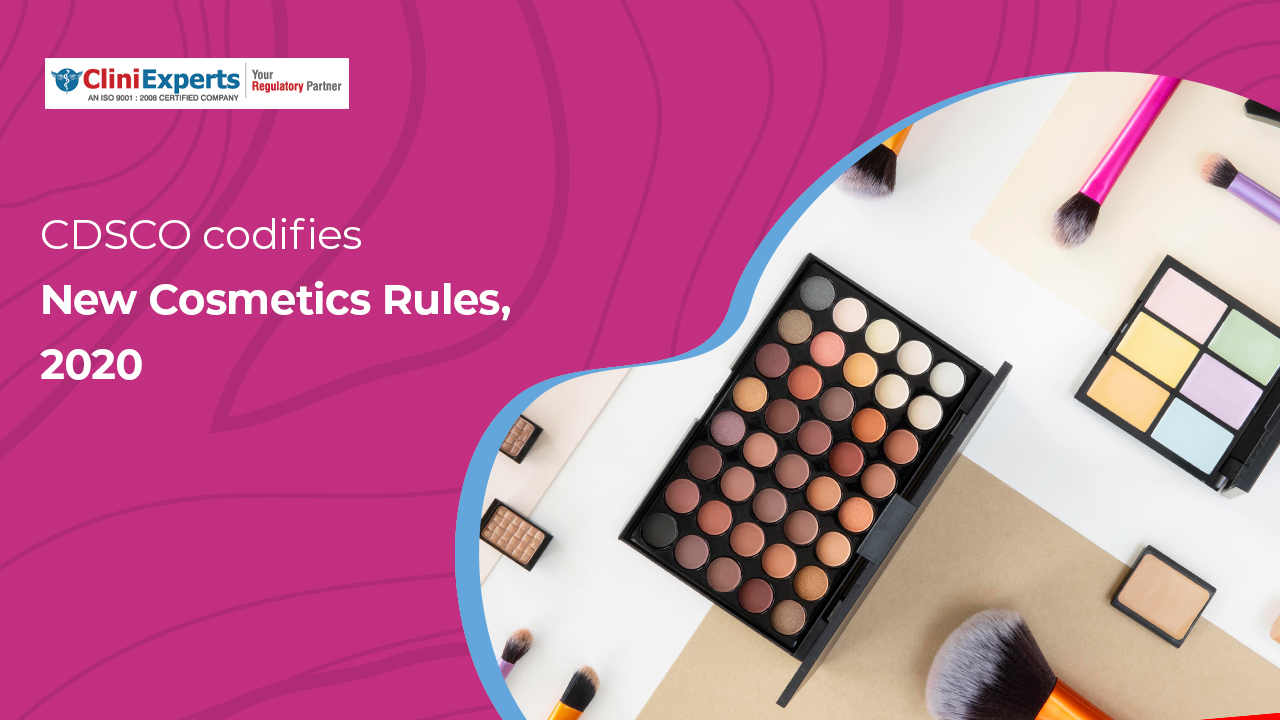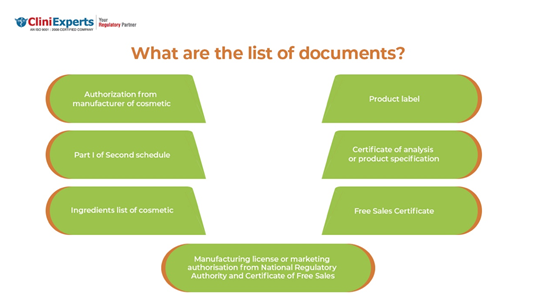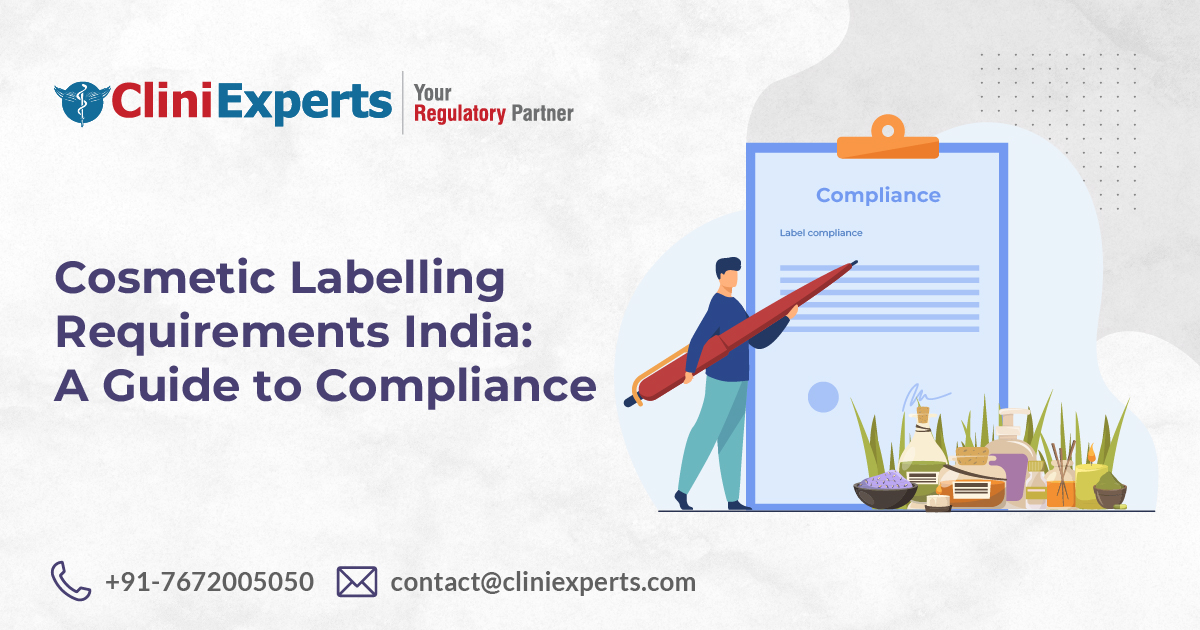CDSCO codifies New Cosmetics Rules,2020

The Ministry of Health and Family Welfare (MoHFW) has notified the Cosmetics Rules, 2020 under the Drugs and Cosmetics Act, 1940. This move is to streamline all functions and bring effective compliance in the cosmetic sector of India. The notification came to separately codify and update the rules relating to import, manufacture, labelling, sale, and distribution of cosmetics in India, which were earlier set out under the Drugs and Cosmetics Rules, 1945. The notification is as per section 12 and section 33 of the Drugs and Cosmetics (D&C) Act, 1940 (23 of 1940). These rules will apply to the cosmetic as defined in clause (aaa) of Section 3 of the D&C Act, 1940 (23 of 1940). Earlier, the Ministry had issued the draft rules and asked for comments and suggestions from the stakeholder. Finally, the Central Government notified the new Cosmetic Rules, 2020.
Things to know about the new Cosmetics Rules, 2020
| Sr No | Forms | Forms |
| 1. | Form COS-2 | Import registration certificate |
| 2. | Form COS-12 | Application for import or manufacturing of New Cosmetic |
| 3. | Form COS-4 | Application for importing cosmetics from manufacturer who already has Registration Certificate for said products |
| 4. | Form COS-4A | Registration Certificate for importing cosmetics from manufacturer who already has Registration Certificate for said products |
The validity of the import registration certificate is 5 years. The validity of Form COS-4A is 3 years. Moreover, there are a total of 80 categories mentioned in the Fourth Schedule. According to 2020 Rules, “Actual manufacturer” concerning the import of cosmetics means a person who manufactures cosmetics at his manufacturing site in a country other than India approved by the National Regulatory Authority or any authority. The Central Licensing Authority may cancel or suspend the registration certificate for a period if the manufacturer or authorized agent or importer fails to comply with any of the Registration Certificate conditions as it thinks fit either wholly or in respect of some of the cosmetics to which it relates. Further, if the cosmetics are manufactured at more than one site, applicant must pay an additional 500 USD for each site where the products are actually being manufactured.
Renewal of cosmetic import license
If there is the failure of payment of registration certificate retention fee on or before the due date, the registration certificate holder is liable to pay the registration certificate retention fee and a late fee. The late fee is calculated at the rate of two percent of the registration certificate retention fee for every month or part thereof within one hundred and eighty days. Otherwise non-payment of such fee during that period, the registration certificate shall be deemed to have been cancelled.
Change in constitution
Suppose there is a change in the constitution of a registration holder or overseas manufacturer after the grant of registration for grant of new registration within a time period of one hundred and eighty days from the change in rules and the existing registration shall be valid till such time. In that case, fresh registration is given, or the application is rejected by the Central Licensing Authority.

What is the registration fee mentioned in Third Schedule of Cosmetic Rules?
| Sr No | Particulars | Fee Amount |
| (a) | Fee for the grant or retention of registration certificate for each category of cosmetic | $1000 |
| (b) | Fee for each variant of cosmetic for the grant or retention of Registration Certificate | $50 |
| (c) | Fee for grant of permission for new cosmetics | $500 |
| (d) | Fee for Renewal of Registration Certificate | Same as fresh registration 2% retention fee for every month to be paid within 180 days |
What is the difference between Old and New Cosmetic Rules?
| Sr No | OLD COSMETIC RULES | NEW COSMETIC RULES |
| 1. | Application for fresh registration in Form 42 | Application for fresh registration in COS-1 |
| 2. | Registration Certificate in Form 43 | Registration Certificate in COS-2 |
| 3. | Validity of Registration Certificate is 3 years | Validity of Registration Certificate is 5 years. |
| 4. | Fee for renewal is based on Applicable category and variant fee | Fee for renewal is Applicable fee along with retention fee at the rate of 2% till 180 days |
| 5. | Particulars of manufacturer and details of cosmetics to be imported filled in Schedule D(III) | Particulars of manufacturer and details of cosmetics to be imported filled in Second Schedule Part-I |
| 6. | Fee for the grant or retention of registration certificate for each category of cosmetic is $2000 | Fee for grant or retention of registration certificate for each category of cosmetic is $1000 |
| 7. | Manufacturing site fee: NA | Each manufacturing site fee: $500 |
| 8. | Concept of new cosmetics: NA | Concept of new cosmetics has been introduced. Application in COS-12 and approval in COS-3. |
| 9. | Standards for 28 cosmetic products in Schedule S | Standards for 37 products in Ninth Schedule |
In the Drugs and Cosmetics Rules, 1945 is amended as per Thirteenth Schedule of the 2020 Rules to the extent that the word cosmetics is omitted from various provisions. In spite of the non-applicability of the Drugs and Cosmetics Rules, 1945, all issuance under the provisions of the Act and the 1945 rules including approvals, permissions, licenses and certificates in respect of cosmetics prior to commencement of the new 2020 cosmetic Rules, will be deemed valid for all purpose till its expiry or for a period of 18 months from the date of notification of the new rules, whichever is later, under the corresponding provisions of said rules.
References:
- Gazette notification G.S.R 763(E) dated 15.12.2020_Cosmetics Rules 2020. Available at: https://cdsco.gov.in/opencms/opencms/system/modules/CDSCO.WEB/elements/download_file_division.jsp?num_id=Njc3NA== .Accessed on 26 th December, 2020.
Recent Posts
Organic Food Labelling In India| Certification, and Import of Organic Food in India

This Article is All About Organic Food Labelling In India and Certification, and Import of Organic Food in India. Explained in Detail About What is Organic Food labelling? Summary Short Description Wi..
Cosmetic Label Compliance India : A Guide to Compliance

Introduction Looking for Cosmetic Label Compliance India? Are you a cosmetic manufacturer or importer navigating the complex world of Indian regulations? Ensuring your product labels comply with the l..
Clinical Investigation Approvals: An Overview of Forms MD-22 and MD-23

Summary Short Description Strict regulatory protocols govern clinical investigations for medical devices. Central to this process are forms MD-22 and MD-23. Form MD-22 is an application to Central Lic..
HAVE A QUERY?
REACH US!Office
New Delhi
Unit No. 324 & 325, City Centre Mall, Plot No. 5, Sector 12, Dwarka, India - 110075
+917672005050
Bengaluru
RMZ Galleria, 1st floor, Ambedkar Colony, Yelahanka, Bengaluru, Karnataka, India – 560064
Call us on
Sales: +91 7672005050
Reception: +91-11-45214546
Timings
9 am to 6 pm (Monday to Friday)


